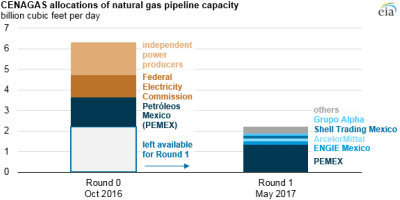Mexico conducts its first natgas pipeline capacity open season
As part of a series of ongoing energy reforms, Mexico’s National Center for Natural Gas Control (CENAGAS) recently conducted the first open season to auction capacity rights on the country’s natural gas pipeline grid. CENAGAS manages Mexico’s Integrated National Natural Gas Transportation and Storage System, also known as SISTRANGAS, which currently has 6,256 miles of pipeline and a total transportation capacity of 6.3 Bcfd.
 |
| Courtesy of EIA. |
CENAGAS was created in 2014 as the public entity entrusted with assigning capacity rights for pipelines that were previously owned, operated, and largely used by Mexico’s national energy company, Petróleos Mexico (PEMEX). Before 2014, PEMEX was the monopoly owner of Mexico’s pipeline assets. Mexico’s energy reforms have provided a process to transition Mexico’s energy sector to competitive markets that are open to both foreign and domestic companies.
To transition to the new market structure, two open seasons were scheduled to auction pipeline capacity rights. The first phase (Round 0) was for reallocating Mexican resources; it was not open to foreign companies. During Round 0, 4.1 Bcfd of the total 6.3 Bcfd capacity was allocated, with 1.1 Bcfd reserved for Mexico’s Federal Electricity Commission, 1.4 Bcfd reserved for PEMEX, and 1.6 Bcfd reserved for Mexico’s independent power producers.
About 2.2 Bcfd of capacity remained for the second phase (Round 1) auction, conducted in May 2017, which was open to both domestic and foreign companies. Data available on the CENAGAS website show that 24 local and international companies requested capacity rights totaling 3.6 Bcfd in Round 1, much more than the 2.2 Bcfd available. An additional 1.3 Bcfd, more than half of the remaining available capacity in Round 1, was awarded to PEMEX. The next-largest shares of the Round 1 auction went to ENGIE Mexico and ArcelorMittal, each getting 7% of the Round 1 allocation, and to Shell Trading Mexico and Grupo Alpha, which acquired 6% and 5%, respectively. The remaining 15% went to 19 other companies. Many of the companies that were awarded capacity rights are in the natural gas retailing and marketing business, although the list also includes industrial customers such as steel and cement companies.
Total demand in the five regional zones in the Mexican pipeline system where capacity was made available in the Round 1 auction exceeded available capacity. Companies expressed high interest in cross-border interconnections with flows from southern Texas to Mexico on both private and CENAGAS-operated transmission pipelines. Mexico's Gulf and North zones share borders with the United States. Capacity in the Isthmus zone, a sixth regional zone in the Mexican system, was not included in the Round 1 auction.
By volume, capacity in the Gulf zone—which includes the Noreste, Golfo, Altamira and Veracruz extraction centers—was the most sought after and was oversubscribed by almost half: 1.7 Bcfd was requested, but only 1.0 Bcfd was allocated. The Kinder Morgan Texas Pipeline interconnect at Pesquería and the Ramones injection points on the Net Mexico pipeline, which bring US natural gas to Mexico, were two of the most oversubscribed points.
The South and West zones were also oversubscribed, with demand exceeding supply by 0.4 Bcfd and 0.1 Bcfd, respectively, mainly because of high interest from several PEMEX industrial and fertilizer projects in the region. The Center zone, which includes Mexico City, was slightly oversubscribed with a mix of industrial, residential, and commercial demand.
Following Round 1 of the open season, CENAGAS conducted three training sessions for pipeline operators that won capacity. The new operators began taking over from state-owned operators on July 1 for one-year contracts. On July 10, CENAGAS held another auction for five cross-border pipelines assigned to the Federal Electricity Commission. However, the auction was declared void, because even though several companies expressed interest, no parties submitted final bids. On Aug. 10, CENAGAS plans to re-hold a public auction for capacity on the five cross-border pipelines.

- ExxonMobil halts 1-Bft3d blue hydrogen project in Texas
- Aramco and Yokogawa commission multiple autonomous control AI agents at Fadhili gas plant
- Ukraine will resume gas imports via Transbalkan route in November
- Mitsubishi to inject $260 MM into Brunei LNG project
- Freeport LNG (U.S.) on track to take in more natgas on Thursday after unit outage



Comments